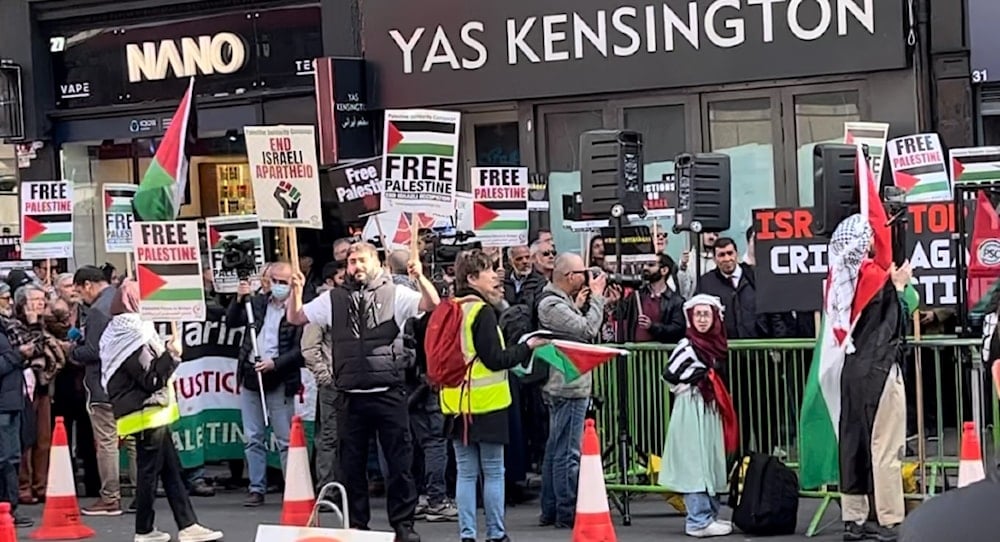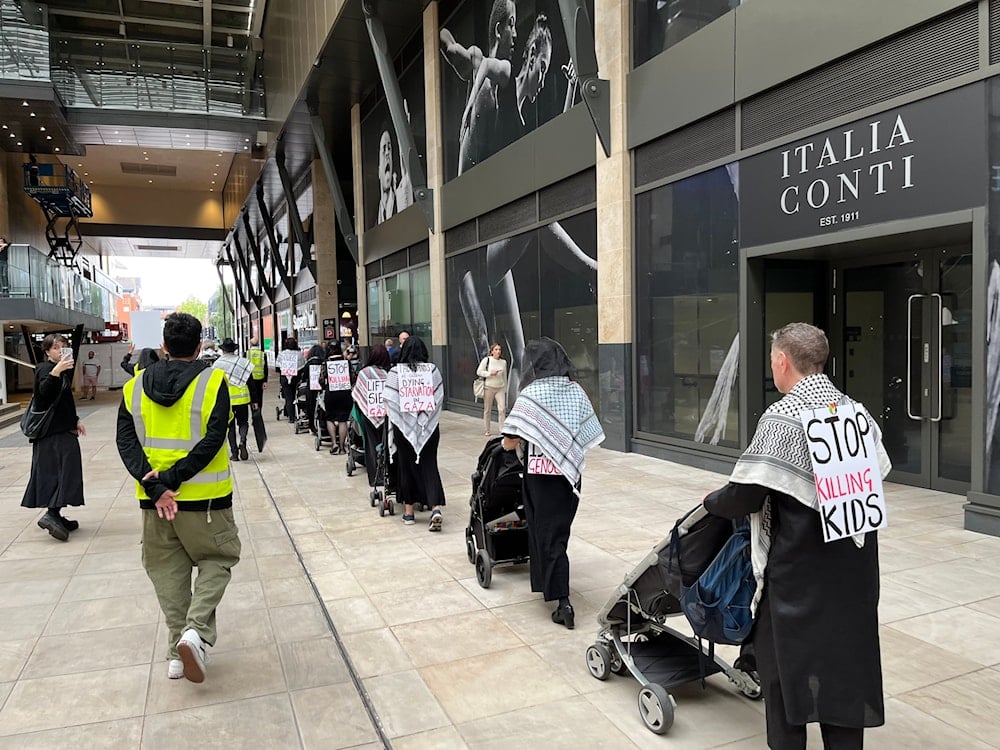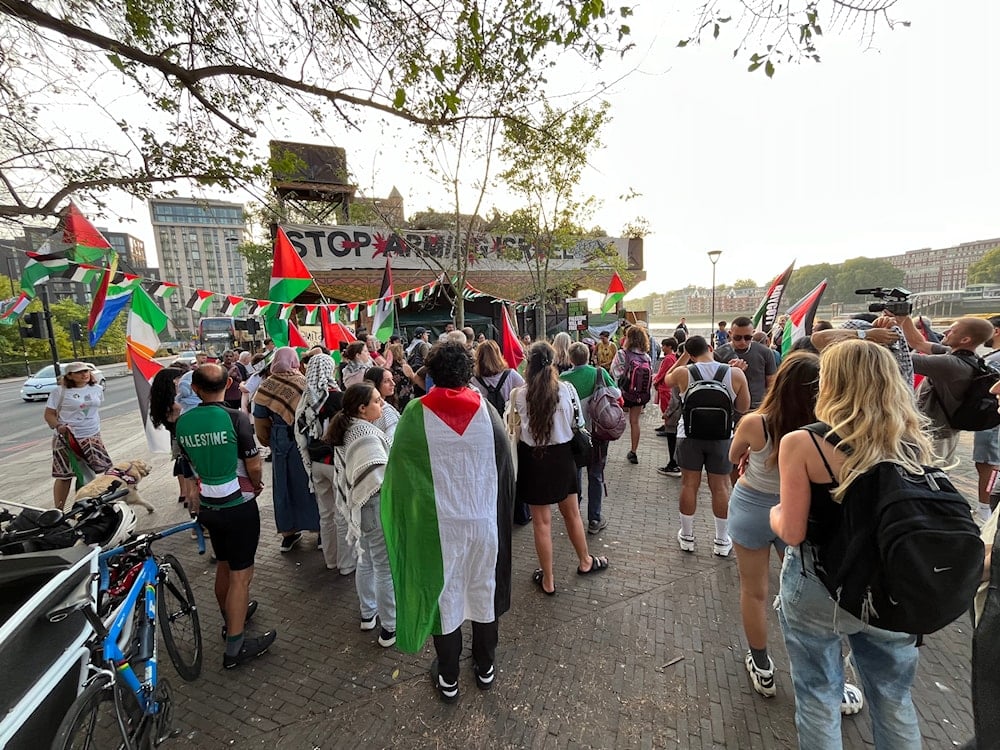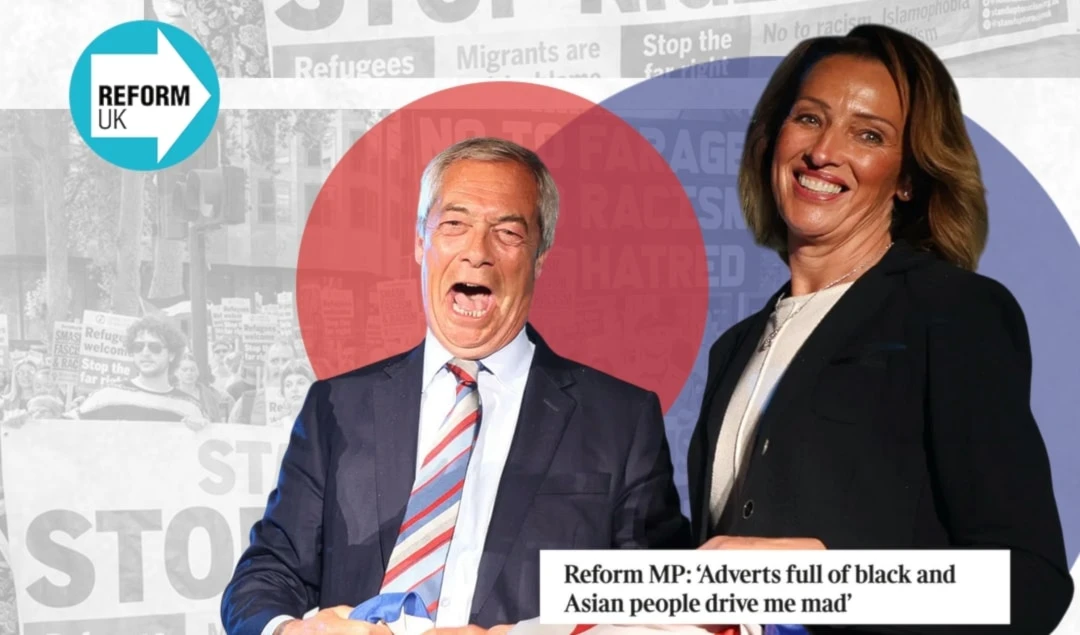The UK’s Grassroots Solidarity for Palestine
The pro-Palestine movement continues strong in the UK, with various cities seeing grassroots protests organized to draw attention to the genocide in Gaza, each with its own unique take.
-

Throughout the UK, different forms of protest are still ongoing in support of Palestine, denouncing Israeli actions, and drawing attention to the oppression of Palestinians everywhere. (Al Mayadeen English; Illustrated by Batoul Chamas)
Kensington High Street, London, April 7th 2023
-

Kensington High Street, London, April 7th 2023. (Sul Nowroz, 2023)
It was mid-afternoon, sunny with blue skies, and Kensington High Street was heaving with shoppers. Some sipped from branded cups bought from nearby coffee stores, others carried shopping bags in various colours and sizes. This is an affluent part of London, and rich in retail.
Just off the southern end of Kensington High Street is a driveway called Palace Green. It’s a private road, well maintained and heavily protected. Large metal gates guard its entrance and surveillance cameras eagerly watch all movements. The road is home to a handful of millionaires, a few billionaires, and the Israeli embassy, which occupies a building originally constructed in 1860, 88 years before "Israel" was invented.
On April 7, 2023, a large crowd, between four and five hundred, gathered opposite the entrance to Palace Green. They were protesting an armed assault on the Al-Aqsa Mosque, in Al-Quds, by Israeli Occupation Forces (IOF) and their subsequent bombing of Gaza.
Unlike the shoppers on Kensington High Street, protestors weren’t there for the retail experience. Coffee cups were replaced by bullhorns; shopping bags by placards and flags and keffiyehs. I watched as the crowd slowly spilt off the pavement and on to the high street, inching closer to the entrance of Palace Green. Traffic was now crawling cautiously amongst protestors.
While everything else appeared to slow down, it happened quickly. A single black car, compact, doors thrown open, young men jumping out. There was arm waving, and pointing as they encouraged protestors to occupy the road: “Sit down. Sit down in the road. We have to do this. Let’s close the road.”
Protestors were confused; police were alarmed. A dozen officers swiftly encircled the men - but what happened next interested me most. Officials from the protest organiser physically directed the men to the pavement. It was force masquerading as persuasion, control cloaked as comradeship. In that moment, I worried the protest had become too hierarchical and its organic nature suppressed.
I was reminded of that April day this weekend after spending time with two groups resisting the genocide in Gaza. Reassuringly, both are self-managing grassroots movements, both act with independence and instinct, and both have preserved the emergent nature of resistance that was quashed outside Palace Green. Thawra, thawra hatta al-nasr.
-

Woking Walking Vigil. (Sul Nowroz 2024)
Woking’s Walking Vigil
Woking is a town 20 miles southwest of London, with a population of 100,000, 25% are under the age of 18. The town is blessed with the UK’s first purpose-built mosque, the Shah Jahan, which was completed in 1889. The popular author H. G. Wells lived in Woking, drawing inspiration from the town for his famous novel, The War of the Worlds. The novel, published in 1898, is about aliens invading Earth, and cleverly explores the universal themes of social hierarchy, fear of those unknown to us, and most notably society’s tendency to deceive itself by telling comforting lies and seeking refuge in soothing falsehoods.
On Saturday, August 31st, comfort and refuge were challenged as truth visited Woking.
“It takes a lot of organisation. We need to think through the logistics, plan the action, mobilise people. It’s a lot of juggling. And then, at the last moment, some people pull out. Family stuff comes up, home emergencies. And so, we re-plan, and now we’re here.”
It is mid-day and a procession of nine pushchairs travels in a single, silent line through the busy shopping area of Woking. The line is accompanied by a lone drummer who announces the sombre arrival of death with a series of deliberate dull thuds. Each stroller, steered by a figure hauntingly dressed in black, carries a photograph of a child murdered in Gaza by the IOF: Hind (aged 6), Reem (aged 3), Fatima (aged 5), Anas (aged 3), Huda (aged 8), Kinda (aged 6), Fayez (aged 3), Kariman (aged 5), Laila (aged 8 months). Some shoppers stop and stare, talking quietly amongst themselves. I can’t hear what they are saying.
The walking vigil makes its way inside a series of shops – Boots, the pharmacy chain, Marks & Spencer, the department store, Tesco, the supermarket, Starbucks, the coffee shop, and fast-food outlets McDonald’s and Burger King. Each either sources products from Israel or has been openly supportive of the IOF's actions in Gaza.
“What we’re doing is very personal, but you can’t take people’s reactions personally. You need a thick skin.”
Once inside the shops, things change. The public, now in close quarters with death, look away. Staff uncomfortably continue to serve from behind tills. Managers become confrontational, raising voices, and asking the procession to leave. I overhear one manager make a joke on his headset to someone somewhere. In death he inexplicably finds humour. On a couple of occasions, customers become verbally aggressive, and on one occasion police attempt to intimidate the procession. Even in death, these children are denied peace.
I find myself gazing at one of the photographs: Huda (8) and Kinda (6). They are sisters, smartly dressed, complete with sun hats and sunglasses. They’re all big smiles and skinny arms, standing tall and full of anticipation. I wonder when the picture was taken, and where they were going – clearly somewhere important. On October 16th,2023, they were murdered by the IOF. It was a Monday.
When the manager was being confrontational, and the shopper aggressive, and the policeman intimidating, none of them looked down at Huda or Kinda, and that is unforgivable. The campaigners from West Surrey PSC, who organised the walking vigil, created a sacred space to honour and remember young Palestinian lives lost, and to urge the people of Woking to help stop the genocide. Perversely, some were more irritated by pushchairs than slaughtered children.
-

McDonald’s Woking, UK. (Sul Nowroz, 2024)
Community Camp for Palestine
Nine Elms, in southwest London, is a place of wide roads and high rise living. It’s modern and convenient and looks out on the River Thames. Property firm DAMAC will sell you one of their Versace branded studio apartments for $900,000. Their three-bedrooms go for a cool $2.5 million.
Tucked away below DAMAC Tower, along the river’s edge is something more daring. It’s square, approximately four meters by four meters, with a dark green exterior and an open frontage. Inside is a single storey open plan layout that can sleep four. There is no heating or running water, and the neighbouring road can get noisy during rush hour. What makes this dwelling, a flimsy tent, so significant is its location – it is directly opposite 33 Nine Elms Lane, where the US embassy is located.
The embassy reaches up 12 storeys, cost a whopping $1 billion to construct and is the largest US embassy in Europe. It is surrounded by a moat designed to capture rainwater; some believe the moat is to defend the site’s perimeter. Part of the exterior is encased in a web of translucent plastic structures devised to reduce glare; a few have suggested the mesh is to minimise the building's vulnerability to electronic surveillance. Suffice it to say the building sparks much debate.
-

US Embassy, London, UK. (Sul Nowroz, 2024)
The message appeared on Signal, “The US has flown 600 weapon shipments to Israel and delivered 100 more by sea. On August 14th Biden approved a further $20 billion in weapons for Israel. Unwavering US support and protection enables Israel to continue its genocide against Palestinians. USA – this is your genocide.”
-

Community Camp for Palestine, London, UK. (Sul Nowroz, 2024)
A response was necessary and within hours plans were being made. A network of activists and campaigners was convened by South West London Action for Palestine. A space for a camp was identified opposite the US embassy, and provisions and equipment were secured.
They moved in on Sunday, August 1st. Within hours the camp comprising tents and some storage units was set up. Next, banners were erected, a solar panel assembled, and two faux concrete blocks representing the miles and miles of separation walls that scar Palestine were positioned into place. ‘We Are All Palestinians’ and ‘End Apartheid’ had been spray painted across the blocks.
-

Community Camp for Palestine, London, UK. (Sul Nowroz, 2024)
At 6 pm on Sunday, the Community Camp for Palestine officially opened.
Camps have a particular significance in the UK. On August 27th, 1981, fifty women walked 100 miles from Cardiff in Wales to an American Air Force base at Greenham Common, after the British government agreed to base US nuclear missiles there. The journey took nine days, and on arrival, the women delivered a letter addressed to the base commander. He refused to meet with them, which proved to be a costly mistake. The women chained themselves to the fence and set up a peace camp that lasted 19 years.
As I speak to the Community Camp’s volunteers, I experience its embryonic nature. Individuals, of various ages and backgrounds, have converged to birth a community that is in constant evolution. There is a life force to this space that was so missing from Kensington High Street.
This community also hurts. It carries a sadness, which regularly surfaces during our conversations. Like many of us, I sense they will never fully heal from witnessing the Gaza genocide. But by being here they are pointing to the 12-story building at 33 Nine Elms Lane and naming their pain.
“We will serve as a continual reminder of the genocide against the Palestinian people, and by being here we are highlighting the role the US is playing in this crime against humanity.”
As I leave the camp it is dusk. I open my phone and a string of messages stored up from the last few hours light up. One penetrates – it contains a picture of a young child kneeling next to an IOF soldier and reads: “Duha Talat is the child in this picture with an IOF soldier in Gaza, and she has disappeared ever since she was seen with this soldier. The soldier has deleted all his socials. We need to find Duha.”
-

Source: Screengrab X @deedeehimawari
It appears Duha has fallen under America’s long dark shadow.

 Sul Nowroz
Sul Nowroz
 10 Min Read
10 Min Read











